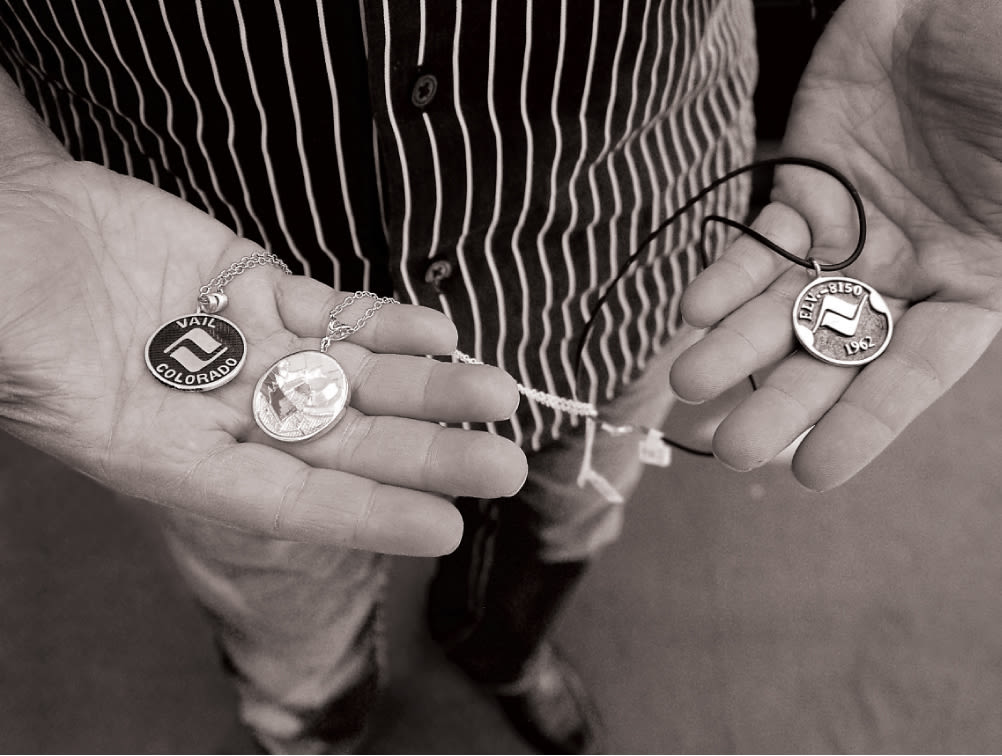The (Mostly) True Story Behind Vail’s Most Coveted Souvenir

The Vail Coin (at left) and its manhole-cover predecessor.
Image: Ted Katauskas
“You know the story of the manhole cover, don’t You?”
asks Amad Akkad, Lionshead Jewelers’ proprietor, dressed in blue jeans and a black-and-white pinstripe shirt, sitting behind a desk in the back office of his store. “This is what I remember: People were stealing the manhole covers in town because they liked them. Says ‘Vail’ on them. They were making coffee tables out of them. ... Late at night, at 2 in the morning, coming out of a bar or something, somebody fell into [an open manhole], and that’s when the town comes out and says, ‘OK, fine. We’ll sell the manhole covers.’ And it all took off from there.”
That citizens actually disappeared into the municipal sewer system may be apocryphal, but this much of Akkad’s account can be verified: Early in 2002, to commemorate the fortieth anniversary of Vail Mountain’s founding, the Town of Vail replaced its generic sanitary sewer covers with a custom design bearing the town’s name, Vail Resorts’ iconic inverted “V” logo, and the words “Founded 1962” and “Elevation 8150.” Almost immediately, the 300-pound, 24-inch-wide, cast-iron lids began disappearing, presumably the work of muscle-bound, crowbar-hefting souvenir hunters.
By July, so many manhole covers had been looted that to discourage theft (and to raise money for the town’s Art in Public Places program), the town began selling fifty-two-pound, full-scale replicas to the public for $295, hawking them on eBay that Thanksgiving as unique gifts for the holiday season. The story was carried on forty-five networks and in 110 newspapers nationwide, and manhole cover sales boomed, generating $50,000 in the program’s first year. In its second year sales were so brisk that the town launched a website and a toll-free number to process orders, added a more affordable eight-inch oiled bronze manhole to its collection, and commissioned jeweler Jim Cotter to design and produce a line of manhole cover jewelry that included money clips, cufflinks, necklaces, charms, bracelets, and earrings.
Akkad took over the town’s production contract for manhole cover jewelry in 2004, at the height of what the city in one press release deemed “manhole cover mania.” That year, sales of manhole covers and jewelry surpassed $100,000. Then, as the novelty wore off, sales waned, having netted only $41,271 since 2007.
Akkad’s solution was to redesign and rebrand the bauble as the Vail Coin, tweaking the logo on the front, replacing the town’s elevation and founding data with “VAIL COLORADO,” and adding a flipside that incorporates local landmarks like the Gore Range with mother-of-pearl snowcapped peaks, a bluebird sky of inlaid turquoise, and the covered bridge and clock tower with jasper rooftops. But the town took a pass, opting instead to slowly sell off its inventory (as of press time, just three large manhole cover replicas—manufactured by a Utah foundry—and a few Akkad-made key rings, charms, cufflinks, and necklaces). In the (perhaps temporary) manhole void, Molly Eppard, the Art in Public Places coordinator, has launched a line of vinyl Winterfest shopping bags and pouches, which a Denver nonprofit makes from recycled roundabout banners.
“The manhole cover was a great idea,” Akkad says. “But what is so sexy about buying manhole-cover jewelry? The story is sexy, but if a guy buys it and takes it back to his wife, she doesn’t know the story and wonders, ‘Why am I getting a manhole cover?’ You’re better not naming it the manhole cover.”
Instead, you give the manhole a new coinage. And voilà, a best-selling souvenir is born.







































